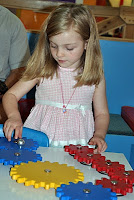Focused Material Exploration - A time set aside while children are arriving and may involve children playing alone, alongside another child or cooperatively with one or more other children and/or a preschool camp facilitator. Children are given the chance to test their ideas, themselves, their relationships and the materials.
Welcome Gathering - The welcome gathering helps set the focus for the day. After the teacher reads a story, children can retell the story, ask questions and participate in planning of the rest of their day.
Museum Exploration - In groups of five with a camp facilitator, children explore, invent and challenge creative solutions in the neighborhoods in the Museum. Special emphasis is placed on the neighborhood related to the weekly focus.
Snack Time - A regularly scheduled snack time, not only provides nutrition for the morning but also gives children opportunity to practice emerging social skills.
Focused Activities - At least two activities, based on the theme for the week, are offered daily. During last week's Summer Preschool Camp, Let's Build, children had the opportunity to practice emerging spatial and geometric abilities as they built forts, created sculptures and made graham cracker houses.
Goodbye Gathering - For young children, understanding and making sense of their world is rooted in what they know and the everyday events in their lives. This is an opportunity to share thoughts and ideas about what happened during camp today! Parents, too, are given a play-at-home ideas, related to children's daily activities.
We just finished our first Preschool Summer Camp week, Let's Build.
For more information about Summer Preschool Camps, click here. Some of our weekly camps still have a few openings.













